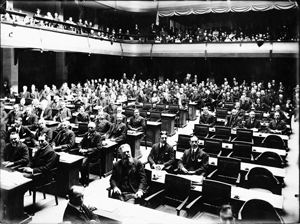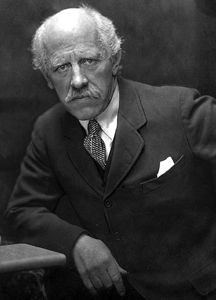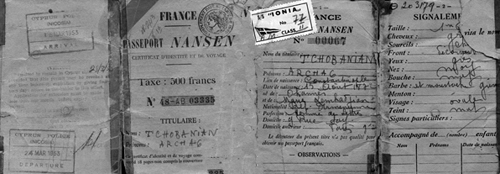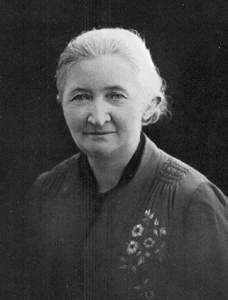03.10.2009
The decision to create the League of Nations during Paris peace conference in 1919 was aimed to maintain peace and promote the spirit of cooperation among nations. The League of Nations started its activities on 10 January, 1920. According to the League Covenant the main organs of the organization were the Assembly, the Council and the Secretariat, headed by the Secretary-General.
From the very beginning Great Britain and France were playing leading roles in this organization. The headquarters of the League was in Geneva (Switzerland), where the assemblies were held. In 1939, after of World War II broke, the League of Nations stopped its activities being unable to fulfill its main goal and mission. Officially the League of Nations was dissolved in 1946, after the formation of the United Nations Organization.
 League of Nations Assembly
League of Nations Assembly
Second Assembly, Geneva, 1921
For several times the Armenian Question was in the agenda of the League of Nations. The Republic of Armenia, proclaimed in May 1918, applied to the League of Nations in May 1920 for full membership. The application, after long discussions, was finally rejected. The US candidacy for the mandate of Armenia also was in the agenda of the League of Nations.
Armenia again applied to the League of Nations in October 1920, during the joint aggression against the Republic of Armenia by Kemalist and Bolshevik armies. After long-lasting discussions the Council of the League applied to the member states and to the USA with an appeal to take necessary steps to stop the hostilities. At that time Spain and Brazil, as member states of the League, expressed their willingness to cooperate with the USA in this question. Nevertheless, the League failed to provide any solution to this issue.
Once again Armenian question was discussed in the League of Nations in 1922. This time it was related to the problem of the establishment of “Armenian hearth” in Turkey. In addition the issues of relief assistance for Armenian Genocide survivors and refugees were discussed to provide their settlement in Soviet Armenia. Once again these plans were not realized.
 Fridtjof Nansen
Fridtjof Nansen
(1861-1930)
The humanitarian activities of famous Norwegian polar explorer, scientist, public activist and humanist Fridtjof Nansen (1861-1930) in the frame of the League of Nations to assist Armenian Genocide survivors were immeasurable. Nansen, the High Commissioner of the League of Nations and at the same time the head of the Repatriation Committee under the League (1925-1929), greatly assisted to repatriation and settlement of Armenians worldwide to Soviet Armenia.
To observe the possibilities of efficient realization of these programs, Nansen and his commission arrived in Armenia in June 1925. In the report to the League of Nations on his visit to Soviet Armenia, Nansen was stating that there was a potential for repatriation of 25-30 thousand refugees in case of provision of necessary relief assistance. After facing the indifference of the League of Nations in reaching a final solution to this problem, Nansen was successful in fundraising and organization of the repatriation of 7000 Armenian refugees to Soviet Armenia.
Thanks to his own efforts during Geneva conference of 1922 Nansen secured a decision to provide the refugees with “Nansen certificates”, on which stamps with the portrait of Nansen replaced the state coat of arms.
According to the decision of the League passed on 12 July 1924 “Nansen passports” were provided for 320.000 Armenians whole over the world who suffered Armenian Genocide. With those certificates the survivors got right of freedom of movement between the member states of the League and the previous limitations applied to them as to people without citizenship were discontinued.
The Treaty of Sèvres signed in August 10, 1920 authorized the League of Nations to carry out certain steps for the punishment of the Ottoman criminals convicted in Armenian Genocide. For this purpose the Turkish Government undertook “to facilitate the operations of mixed commissions appointed by the Council of the League of Nations to receive the complaints of the victims themselves, their families or their relations, to make the necessary enquiries, and to order the liberation of the persons in question”. (Article 142)
 “Nansen passport” given to Armenian refugees
“Nansen passport” given to Armenian refugees
“The Turkish Government agrees that arbitral commissions shall be appointed by the Council of the League of Nations wherever found necessary. These commissions shall each be composed of one representative of the Turkish Government, one representative of the community which claims that it or one of its members has been injured, and a chairman appointed by the Council of the League of Nations”.
“The Turkish Government undertakes to facilitate in the fullest possible measure the work of the commissions and to ensure the execution of their decisions, which will be final. No decision of the Turkish judicial or administrative authorities shall prevail over such decisions”. (Article 144)
“The Allied Powers reserve to themselves the right to designate the tribunal which shall try the persons so accused, and the Turkish Government undertakes to recognize such tribunal”. (Article 230)
In addition it was pointed out the possibility of establishment of the first special international court in the history of international relations: “In the event of the League of Nations having created in sufficient time a tribunal competent to deal with the said massacres, the Allied Powers reserve to themselves the right to bring the accused persons mentioned above before such tribunal, and the Turkish Government undertakes equally to recognize such tribunal”. (Article 230)
In addition to those issues the League of Nations held discussions on the destiny of women and children who were kidnapped and kept in Muslim families in Turkey, Asia Minor and contiguous regions.
This problem had been the focus of attention of the League of Nations before. Particularly, the League decided to establish an investigative commission with a headquarter in Constantinople. The High Commission of Allied states was expected to support this new commission. The Council of the League included Dr. Kennedy and Miss. Cushman into this commission to coordinate the work in Constantinople, while Danish missionary Karen Jeppe was appointed in Aleppo for the same purpose.
 Karen Jeppe
Karen Jeppe
(1876-1935)
Though the commission came across numerous obstacles during its work, it succeeded to collect the necessary information about forcibly retained Armenian children and women. Thus, according to a report submitted by the British High Commissioner in Constantinople, 2300 children were reclaimed from Muslim institutions and homes where they were kept by force. According to the information provided by Armenian Patriarchy half of the children sheltered in the orphanages in Turkey were Armenians, among them 6000 children were in very poor condition. Many of young Armenian women were kept in Muslim harems, where it was practically impossible to access.
According to the report of the Fifth Committee, the efforts for reclamation of retained Armenian women and children came across obstacles posed by Turkish side. For instance, Christian children were forced to forget their origins, their birth certificates were falsified and the names of Christian children were struck out and Turkish names super-imposed. Many of children, living in Turkish orphanages, were introduced as Kurds, but in fact they were Armenians. The same difficulties emerged while finding and reclaiming retained Christian women. Report also mentions that
“it is almost impossible to get at them, as an entire people was an accomplice to this crime”.
The report of Mr. Cunha, Representative from Brazil, on the deportation of women and children in Turkey and adjacent countries was introduced to the Council of the League on 30 August 1921. The report stated that 90.819 retained Armenians were restored to their relatives and the same number of Christian women and children were detained in Turkish houses.
In her letter of 16 July, 1921, to the Secretary-General of the League of Nations Miss Cushman stated that the total number of Armenian orphans reclaimed was 90.819, while the number of Armenian orphans still in Turkish institutions and homes was 73.350.
Thus, the facts circulating in the League of Nations obviously confirm the widespread Turkish policy of forced Islamizing of Armenian children and women. Later the United Nations Organization, that succeeded the League of Nations, adopted a “Convention on the Prevention and Punishment of the Crime of Genocide” on December 9, 1948. According to the point (e), Article II of the Convention, Genocide also means
"forcibly transferring children of the group to another group".
In conclusion, the documents of the League of Nations, clearly prove that the policy towards the Armenians in the Ottoman Empire within 1915-1922 was a state organized and implemented genocide.
For other League of Nations resolutions, click to download.





